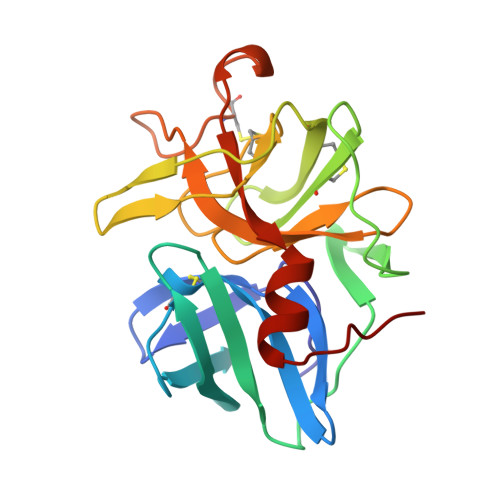Conformational substates in enzyme mechanism: the 120 K structure of alpha-lytic protease at 1.5 A resolution.
Rader, S.D., Agard, D.A.(1997) Protein Sci 6: 1375-1386
- PubMed: 9232638
- DOI: https://doi.org/10.1002/pro.5560060701
- Primary Citation of Related Structures:
1TAL, 2ULL - PubMed Abstract:
Insight into the dynamic properties of alpha-lytic protease (alpha LP) has been obtained through the use of low-temperature X-ray crystallography and multiple-conformation refinement. Previous studies of alpha LP have shown that the residues around the active site are able to move significantly to accommodate substrates of different sizes. Here we show a link between the ability to accommodate ligands and the dynamics of the binding pocket. Although the structure of alpha LP at 120 K has B-factors with a uniformly low value of 4.8 A2 for the main chain, four regions stand out as having significantly higher B-factors. Because thermal motion should be suppressed at cryogenic temperatures, the high B-factors are interpreted as the result of trapped conformational substates. The active site residues that are perturbed during accommodation of different substrates are precisely those showing conformational substates, implying that substrate binding selects a subset of conformations from the ensemble of accessible states. To better characterize the precise nature of these substates, a protein model consisting of 16 structures has been refined and evaluated. The model reveals a number of features that could not be well-described by conventional B-factors: for example, 40% of the main-chain residue conformations are distributed asymmetrically or in discrete clusters. Furthermore, these data demonstrate an unexpected correlation between motions on either side of the binding pocket that we suggest is a consequence of "dynamic close packing." These results provide strong evidence for the role of protein dynamics in substrate binding and are consistent with the results of dynamic studies of ligand binding in myoglobin and ribonuclease A.
Organizational Affiliation:
Graduate Group in Biophysics, University of California at San Francisco 94143-0448, USA.
















